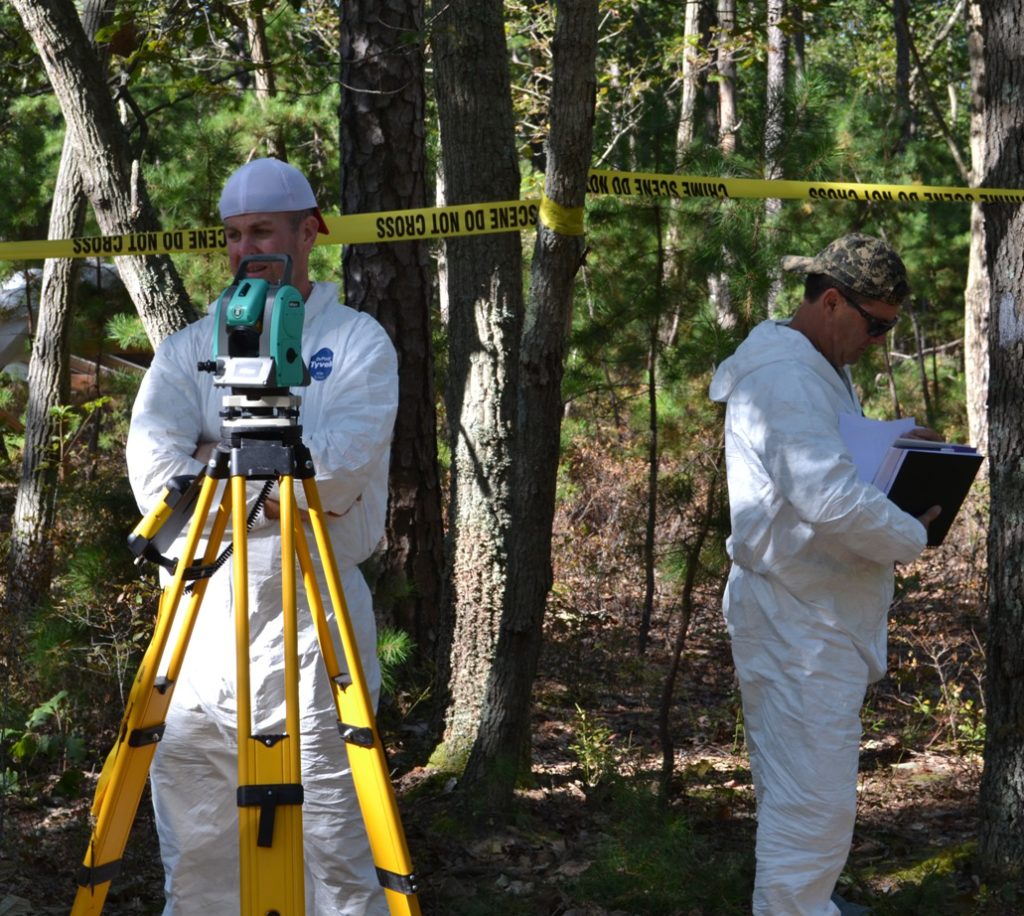Kimberlee Sue Moran – A Day of Archaeology, 2016
Back to PAF Home
Back to 2016 Philadelphia Day of Archaeology Index
Back to Philly Day of Archaeology Main Page
~~~
Forensic Archaeology: Indiana Jones meets Gil Grissom
by Kimberlee Sue Moran

Image 1 – A feature indicative of a clandestine grave.
It’s a sunny April morning and I’m leading a team of professionals in the investigation of an area of disturbed soil in a thickly wooded parcel of land behind a plowed field somewhere in Southern New Jersey. A few scrapes with a flat-bladed shovel reveal a distinct line between sandier, lighter soil and the darker soil that surrounds it (Image 1 above). The team takes photographs with a scale and North arrow in the frame. They produce a plan drawing of the anomaly and they begin setting up equipment such as a shaker screen, 5-gallon buckets, pointing trowels, and a Munsell Soil Chart.
For those of us experienced in field archaeology, this sounds like a normal day “at the office,” but in this instance the team are wearing Tyvek suits and are setting out evidence bags in addition to the usual archaeological tools. Instead of human remains from hundreds of years ago, this team is about to excavate a clandestine grave containing a modern murder victim (Image 2).

Image 2 – Here I am with participants of a 2-day forensic archaeology field course for police and field professionals, April 2016.
Most of us are familiar with shows such as CSI and Bones and some of us are avid fans (not me!). In reality crime scene work is not nearly as sophisticated as what is portrayed on television. Many police departments don’t even have dedicated crime scene personnel. The crime scene units that do exist vary widely in their training and range of capabilities. Some do nothing more than take photographs and some are staffed by re-assigned police officers rather than specially trained professionals. National standards of best practice and accreditation do not currently exist in the United States.
Forensic archaeology is the application of archaeological methods, such as excavation, documentation, recovery of artifacts, site interpretation, and site reconstruction, to modern investigative work. This includes homicide investigation, mass fatality incidents, human rights violations resulting in mass graves, and even archaeological crimes of vandalism, looting, and black market antiquities. In order for it to be “forensic,” there must be some sort of intersection with the law or judicial proceedings.
Forensic archaeology doesn’t have much of a profile in the United States but that is about to change. In September 2017, Arcadia University will launch a new graduate certificate for archaeologists looking to gain a solid forensic skill set. Training in police procedures, expert testimony, environmental evidence, forensic anthropology, spatial analysis, and geoforensics are all included. Graduates of the program will be qualified for positions in death investigation, crime scene processing, human remains recovery, or even traditional archaeological work with an enhanced skill set of mapping, scene documentation, geophysical survey, and human remains excavation (image 3).
Just as Indiana Jones inspired a generation (including myself) to take up a career in archaeology, Gil Grissom and the CSI team are doing the same today for forensic science. As archaeology has moved away from the treasure hunting and looting of the late 19th and early 20th centuries into a codified discipline with best practices and ethical standards, so, too is crime scene work. Archaeology has a lot to offer the forensic community. It is my hope that by offering forensic training to experienced field archaeologists, we can start building bridges to move all of us forward together.

Image 3 – Police officers learn how to use a total station to map an outdoor scene.
Kimberlee Sue Moran, MSc, RPA
Assistant Program Director
Masters of Science, Forensic Science Program
Arcadia University
Glenside, Pennsylvania, USA
This blog entry can also be read as part of the International Day of Archaeology Blogging Project here…
by admin